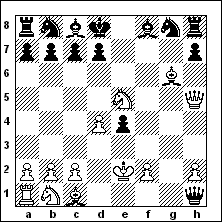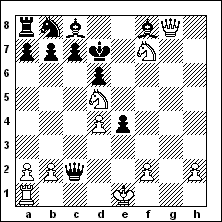THE SPANISH COURT and FIRST STEPS ON LG
by Alejandro Melchor
It is generally accepted that the Moorish introduced chess in Europe when they conquered the Iberian Peninsula between the years 900 and 1000, although in the Arabic method of play.
The next reference arise from the rules collected by the King Alfonse X of Castille in 1283 (where it is already shown some new modality on the moves on the Queen and the Bishop which it would carry to the origin medieval chess). Familiarity with chess was already becoming a mark of culture; during Middle Age it was a favorite game at royal courts, and younger members of the nobility were often sent to court to complete their education. Chess was an item of the educational equipment; the pieces - horses, infantrymen, chariots, Kings, Queens - had logical places in the field of battle, so that knowledge of the rudiments of the game was thus acquired and transmitted as part of the general quest for learning on the part of the nobility.
In Italy, where “scachi” was a more democratic activity, the medieval universities provided Europe’s chief reservoir of popular learning, and while chess was certainly not on the curriculum of the college, it inevitably became part of the curriculum vitae of the visiting student. Italy was well situated to serve as nucleus from which chess love could spread homeland of such medieval learning and the center of Europe’s official religion. Italian players showed more willingness to experiment than their Spanish colleagues (presumably because they were less under Moslem cultural influence) and thus we find they were the first to adopt new rules that we accepted for the modern game (that is, the game in which Bishops and Queens have their extended moves, the double initial move of the pawns, the consistent castling practice, and the rule that the stalemate was a draw).
It is true that the first text detailing the modern game was written in Spain by Lucena in 1497, but Lucena himself asserts that his material came from Italy, thus modern chess was played there before 1500, but in Spain during the earliest decades of the sixteenth century.
In the book of Lucena, entitled “Repeticion de amores e arte de ajedrez con CL juegos de partido” there is still moves of pieces in the old manner (exactly 76), but in the other ones and especially in the openings, the pieces has moves according to the new rules (74) and their veritable importance, besides he is the first modern theorist of chess, is the quantity of remarkable ideas that he suggests.
According to the great chess historian H. Murray, Lucena is also the author of the famous Gottingen Manuscript, a 33 page essay in Latin written around 1500.
So, the 16th century is very important for chess of the Iberian Peninsula.... and for our Gambit. In 1512 the “Quest Libra e da impale gaucherie a Scachi et de le partita” was published, written by a Portugese apothecary called Damiano. The book was an overwhelming success — translated to 8 languages -- and it went through 7 editions before 1561. The rules of play are exactly like Lucena’s, as soon as some advices and problems — thus there are readers who believe that he plagiarized the Spanish author, but only changed the numeration and the order — , but our interest is that he considered there were only two reasonable openings, 1e4 and 1d4. According J M Lobato (in”El Gambito de Greco”, 1914) citing H. Staunton, our Gambit looks like arise from Damiano and T. Kosten is of the same opinion (“The Latvian Gambit”, 1995, page 5). I myself cannot verify it, as he described an opening in which a pawn was sacrificed for the sake of better position, but in 1561, Ruy Lopez wrote another book in which he described this pawn sacrifice as “el gambito” (it seems it was the move 2 ... f6), but he himself refuted it drastically in his analysis. The word “gambito” created by the Spanish master means “trap”, it derives from the Italian “gambetto”, the name seems appropriate for any type of opening in which the opponent is offered a pawn as bait, and by the early 16th century it was used to describe pawn sacrifice openings. Ruy Lopez, who justly criticized much of Damiano’s mediocre openings analysis, was a priest born approx.1540 in Zafra, Extremadura and was considered the leading player of that century. His chess ability gave him International fame and he was one of the favorites in the court of Philip II. In 1560 he went to Rome on ecclesiastical business and while there defeated all best local players, including Leonardo da Cutri. He also practiced with success playing blindfold chess. After returning home he published his famous “Libro de la invención liberal y arte del juego del ajedrez” (Alcala de Henares, 1561), translated some years later to both Italian and German, which served as a guide for future chess books. In 1575 return to visit Gregory XIII and he obtained new victories over his opponents, but two years later, in a series of matches arranged by Philip II, he lost to Polerio firstly, and to Paolo Boi a few months later.
It was the Golden period of Spanish chess, according a list of the Italian Pietro Carrera in his ”Il guioco degli Schachi” (1617) where names such as Alfonso Ceron, Santa Maria, Pedro Pedrosa, Tomas Esquivel, Escovara and others deserved attention.
In 1575 Spanish King organized a match in Madrid and it is relatively well documented (there is even a picture titled “Il Puttino alla corte del re di Spagna” by L.Mussini). This demonstrates the interest of Spanish court for chess. In accordance with time chronicles, the King had inherited inclination for chess of his father, Emperor Charles V. The best players from Spain and Italy participated, represented by Ruy Lopez and Ceron; and Leonardo y Cesare Polerio, respectively (some sources tell the other player was Paolo Boi). Of course, it is very well known that Leonardo defeated Lopez, but is noteworthy for us that in one of these games a form of pseudo Latvian Gambit was employed after 1e4 e5 2Nf3 d6 3d4 f5 etc.
The victory of Leonardo start the decadence of Spanish chess that is emphasized with the arrive of Giachimo Greco, but it seems the Spanish court continued now with Philip IV doing patronage, and good evidence of this is he himself was the last years of his life in Madridian court.


































